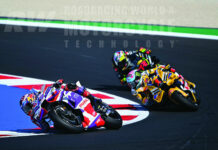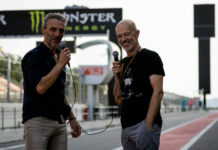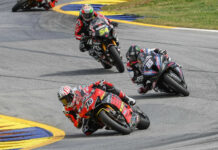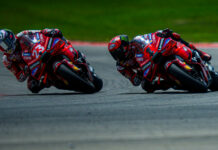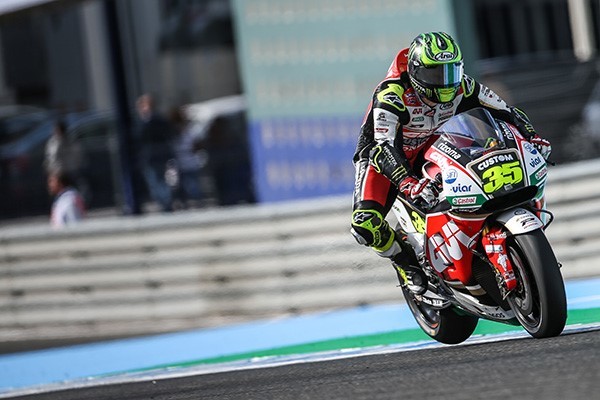Brembo Brake Facts for the Catalan 2017 MotoGP
Viñales, Marquez and Pedrosa are the home players for one of the most challenging GPs on brakes
DETROIT – After France and Italy, MotoGP returns to Spain for the Catalan motorcycle Grand Prix, the seventh race of the 2017 World Championships to run June 9-11 at the Circuit de Barcelona – Catalunya. Of the four Iberian matches, this is the real home race for Maverick Viñales, Marc Marquez and Dani Pedrosa, who grew up only a few miles from the track.
The first stone of the circuit was laid in February 1989 and the track was inaugurated on September 10, 1991 with a car race, the Spanish Tourism Championship. Class 500 took to the track in 1992 and four races of the GP Europe were disputed there, which later adopted the current name of Catalan motorcycle Grand Prix.
With a length of2.96-miles, it has seven turns to the left and nine to the right and boasts a main straight of over a half mile. Given the layout, in the past the Grand Prix motorcycles have set numerous speed records. Starting this year, after modifications to turns 14 and 15, the Grand Prix motorcycles will use the same layout as Formula 1.
Except for the long straight, all decelerations are sharp and in rapid succession. The asphalt temperature is particularly high and causes brake cooling problems. Therefore, the work temperatures of carbon discsand pads are rather high during the GP: However, thanks to Brembo’s investment in materials and production processes over the past decade, the braking system is also fully effective at temperatures close to 800 degrees.
According to Brembo technicians who assist all MotoGP pilots, the Circuit de Barcelona – Catalunya falls into the category of highly challenging circuit for brakes. On a scale of 1 to 5 it earned a difficulty rating of five, value reached only by the Red Bull Ring of Spielberg, Twin Ring of Motegi and Sepang International Circuit. The other three Spanish tracks all ranked lower: a rating of four for Jerez and Aragon, three for Valencia.
The demand on the brakes during the GP
Along with the track of Austin, the Circuit de Barcelona – Catalunya is the only track of the first half of the Championship in which the GP bikes decrease speeds by 124 mph when braking, twice every lap: in the first turn deceleration is 149 mph while at Turn 10 is it 127 mph.
During each lap, pilots actuate the brakes 10 times for a total of half a minute per lap: even in Valencia, which totals nine braking applications per lap, pilots use the brakes 30 seconds per lap. On the Barcelona track, Formula 1 cars use brakes for less than 14 seconds. This means that brakes are used 28 times during the Catalan motorcycle Grand Prix and only 18 percent during the Spanish F1 Grand Prix.
This is also due to the four brake applications in which maximum deceleration is shy of 1 g; average deceleration of the Circuit de Barcelona – Catalunya is around 1.08 g. Only Sepang, Aragon, Jerez and Austin have lower values. As is fairly obvious, in Barcelona instead Formula 1 deceleration reaches 4.2 g.
Summing up all of the force applied by a rider on the Brembo brake lever from the starting line to the checkered flag, the result comes in at more than 2645 lbs., at each lap pilots are required to exert a force of 90 lbs., which is considerable given the high ambient temperatures in which they race.
The most demanding braking sections
Of the 10 braking sections at Circuit de Barcelona – Catalunya, two are classified as demanding on the brakes, three are of medium difficulty, and the remaining five pose only a light challenge on the braking systems. Four of the light brake zones are towards the end of the lap.
The most difficult braking section is at first turn: the GP bikes hit the turn at 211 mph and enter it at 63 mph after traveling 312 yards in deceleration. Interestingly, Formula 1 cars reach the braking section at a lower speed, “only” 201 mph but enter the turn at 94 km/h, a speed obtained after only 55 yards of deceleration.
In order to complete the braking section, GP pilots hit the brakes for 5.1 seconds and exert a force of 14.8 lbs. on the lever. The 1.5 g of deceleration beats the deceleration of the Alfa Romeo Giulia Quadrifoglio from 127 mph to 0 mph by 0.35 g. The pressure of Brembo HTC 64T brake fluid tops at 11.6 bar.
The riders also take a taste of 1.5 g in deceleration also at Turn 10. Speed plummets from 166 mph to 39 mph in 5.1 seconds and 241 yards. At that moment, the force on the lever is 14.1 lbs. and the pressure of the brake fluid is 11 bar.
Turn 7 is the most demanding turn out of those ranked for average difficulty. GP bikes go from 143 mph to 65 mph in a mere 168 yards and 3.4 seconds. The brutality of this deceleration is felt by the 1.4 g experienced by the riders.
Brembo performance
All 21 editions of the Catalan motorcycle Grand Prix were won by bikes with Brembo brakes, as also the 4 editions of the Europe GP disputed on this track: 12 victories for Yamaha, 10 for Honda, two for Ducati and one for Suzuki. Valentino Rossi has claimed a total of 7 500-MotoGP victories, also winning the 250cc two times and the 25 once, and always using Brembo braking systems. The Italian brakes also played a part in Johann Zarco’s triumph of the last two editions of Moto2.


